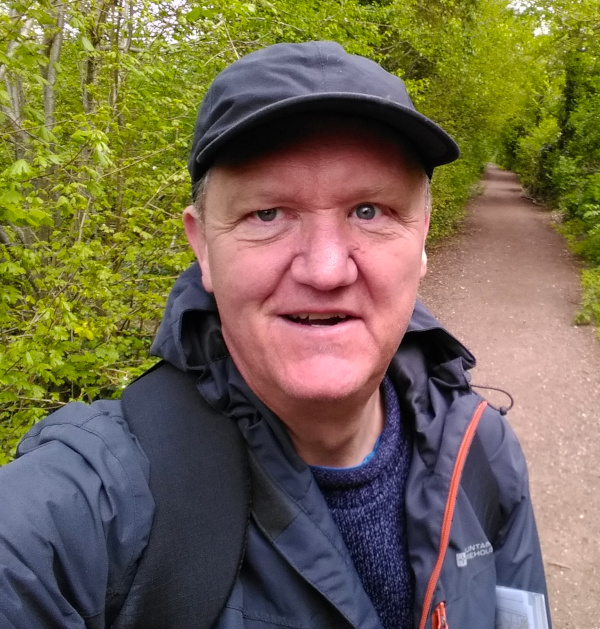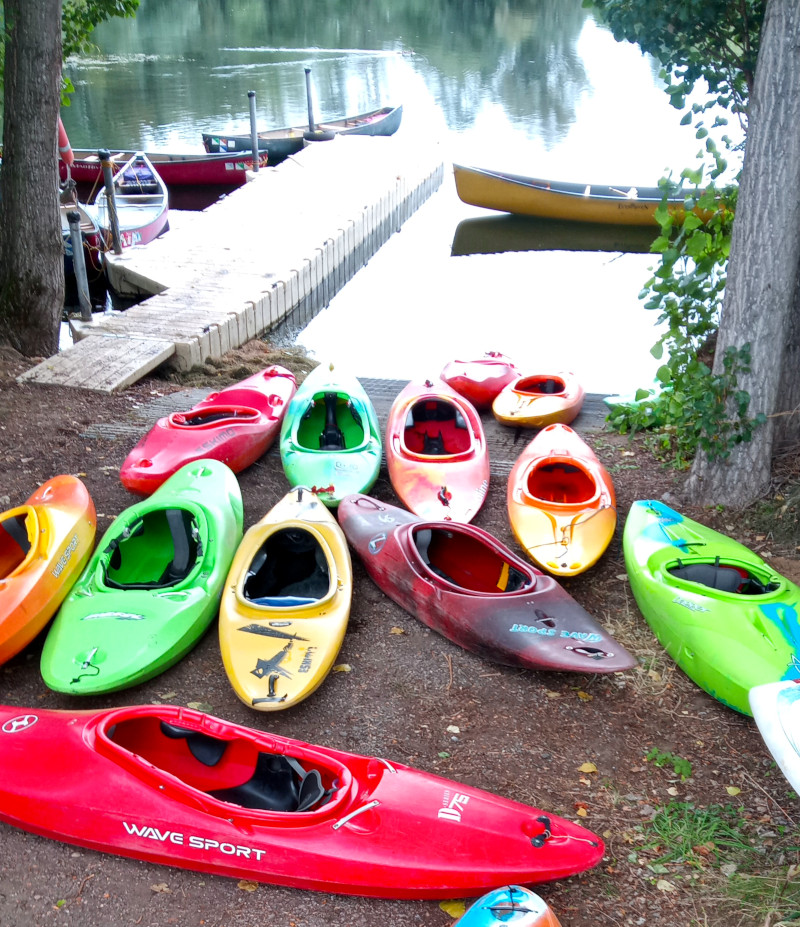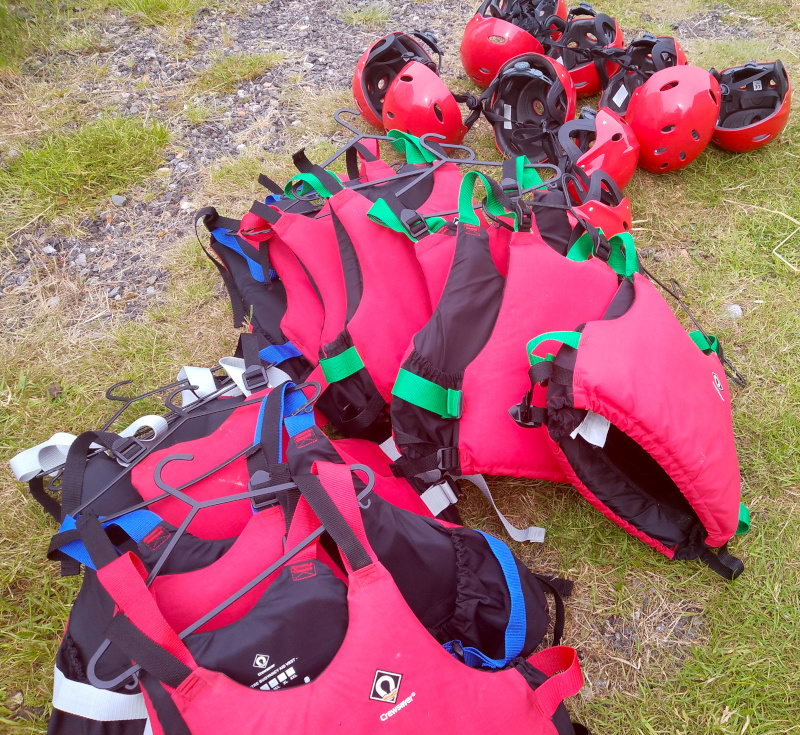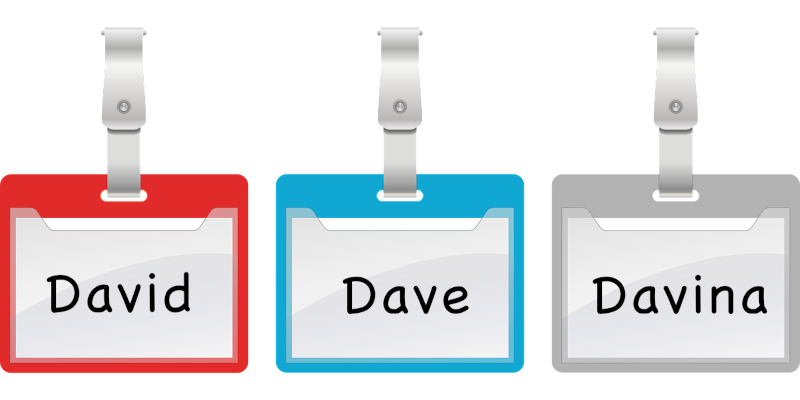How to run the best paddle sports sessions
 Dave out and about in the wilderness
Dave out and about in the wildernessI'm a freelance outdoor instructor. I generally work from January through to September - sometimes longer - doing paddle sports and D of E supervision.
I enjoy the work - the varied locations, jobs and people I meet.
It can be lonely because I spend several days - even full weeks away in the van.
It has enabled me to hone my skills when introducing paddle sports to new students though.
Below I'll talk about how I run sessions and how I try to make them the best sessions I can.
It's in no particular order - just as it came to me when writing it.
 Kayaks and canoes ready for a paddle sports session
Kayaks and canoes ready for a paddle sports sessionEvery group is different and every person is individual. The dynamics of how this plays out during a session can be challenging. Focusing on delivering a fun, safe and progressive session are my main goals.
It doesn't mean everyone progresses at the same rate or even does the same activities. I try to mold the session to each person and the learning journey they are on.
Deliver a fluent and relevant session
Sometimes the sessions are all about fun. Paddling, tipping in, swimming and splashing around. When the conditions and weather are favorable, this is a fantastic session for some groups.
Others prefer a short trip or to play games. That's fine too.
I do have an underlying mission of highlighting the need to be safe around water. In the age brackets I work in, 8 through to 18, water safety is often lacking.
Several UK wide bodies, including the Canal & River Trust, are promoting water safety. I endorse this and I'm glad to say many of my sessions have a water safety element - although it may not be obvious to the student.
Delivering a session requires careful thought and concentration. It's easy to deliver a 'standard' session without tailoring it to the needs of the group.
The preparation begins even before the students arrive. Considering the best craft and equipment for the session and getting these ready and checked, means the session can start promptly.
Mapping out the core areas of the session in your mind gives the opportunity to work out alternate plans for bad weather, smaller/larger group size and other factors relevant to the venue.
The student needs to see a fluent session and any 'challenges' need to be dealt with as covertly as possible.
In my experience, the first five minutes of the session are critical. These minutes set out your stall for the session and give the group a flavour of who you are and what you are delivering.
These minutes are used to introduce yourself, check the group are the correct group on the correct activity, check any previous experience, find out any medical information and reassure the group about the upcoming session.
Set expectations
I also set my expectations for behavior. Paddle sports are dangerous activities and anyone not willing to follow safety instructions will be asked to leave the session.
I do recognise "enthusiastic" behavior and encourage this under close supervision. There is a line though and it cannot be crossed.
I find that most of the groups understand the rules and are not keen to miss the session.
Kitting the group out with safety kit - helmet, wetsuit, buoyancy aid etc - gives a further opportunity to interact with the group and spot anyone that might be anxious or scared. Highlighting at this stage gives you a head start on reassuring them
 Buoyancy aids and helmets ready for the session
Buoyancy aids and helmets ready for the sessionThere is always the option to bail on the activity. Sometimes students do this. I do work with them as much as I am able in a group environment to encourage them to give it a go. And mostly this works. They get on the water, hear me praising them for their efforts and this often seems to motivate them to continue.
If a student bails, that is fine. It is not the right time for them. Maybe next time.
During the session, I am looking at each student and watching how they are interacting with the group, using their equipment and conducting themselves on the water.
This gives me an opportunity to praise great skills and encourage better skills if needed. It also allows me to dynamically adjust the session to the group.
If paddle skills are low, then some demos and games might work. If paddle skills are good then a trip might be in order.
Find session champions
I look for session champions. These are students that have above average paddle skills. Perhaps they have paddled before or are just a natural.
I often use these students to demo paddle skills, help their friends and take a lead in the games. Students enjoy this and the group sometimes respond better to their friends than an instructor.
I seek out any students who are not following the normal progress in a session. I work with them to establish what the issue might be and work out a way to bring them into the session. I might do this gradually in a larger group and in a smaller group I might work directly with them.
Where available, I bring in any shore based leaders who can motivate and encourage from land. This is very effective and the distraction for the student often does the trick.
Managing capsizes and paddlers in the water is an important part of the session. Every second in the water is draining the student of energy to the point where they might quit the session.
I have a 'sleep' activity that means the rest of the group are safe while I deal with the capsize. Usually this is quick and, once back in the craft, they can be motivated to paddle to warm back up.
I quickly decide the most effective way of getting them back in their craft. Sometimes it is best for them to swim to the side and re-enter the craft from there. An on water rescue is an option with students who are strong enough to haul themselves back in the craft or small enough to be hauled back in.
Bring plenty of energy
I have seen many sessions run by other instructors that are dull and lack luster. It's like the instructor is 'going through the motions' and cannot be bothered. It's so sad to see these sessions especially for the students.
If the instructor is not enthusiastic about the session, how can you expect the students to be?
I try to be lively and interact as much as possible as early as possible in the session. This might even be before the official session starts.
Being animated - using my body to move around, wave my arms and doing stuff that keeps them engaged is part of my sessions.
I also don't mind being the butt of jokes. It's important to bring laughter to the session. Laughter releases endorphins and triggers feelings of pleasure.
Sometimes students or leaders crack jokes and this is brilliant too. I enjoy having a laugh.
Caveat: The humour is never derogatory, rude, abusive or vulgar. It is toned to the students and put into language that they are familiar with and use.
Be heard when you need to be
Your voice is the greatest instrument you own. It gives you a powerful weapon to communicate instructions, intentions and feedback to students.
I use my voice as effectively as I can. I keep the volume at a level that is pertinent to the point I am making or instruction I am giving. Urgent commands will be loud - very loud sometimes. Never screaming or shocking - but loud and commanding. The student needs to know that they must respond - NOW.
My general volume is mid range. This ensures every student has the best chance of hearing me. Sometimes I go quiet - especially when speaking one to one with a student. This encourages them to focus on what I am saying.
If you cannot be heard, it makes communication with the group really difficult.
Use words they understand
Every group is made up of different students who are at different levels in their everyday understanding. I try to use words and language that is understandable to them and that they can relate to.
They generally won't understand paddle sport specific language - for example, bow and stern so use front and back instead.
Examples I give are time period relevant to them - rather than to me. My film and music references from the 80s and 90s fall flat on students born 15 years ago.
Trying to find common ground generates plenty of laughs as they try to 'educate' me to their cultural references - eg. Mr Beast, Conan Grey, Taylor Swift, Ed Sheeran and of course, Anime.
Communicate with your eyes
Eye contact is so important when speaking to the group or individuals. With groups, I look around the group as I am speaking. Making sure I am not looking at the ground, random distant objects or staring out the same person.
As my eyes move around, I can get the focus of a student as I might ask a question or make a key point. I'll use by hand, palm towards them to bring them into what I am saying. This is a great way of interacting and marking which students you wish to interact with.
If I notice a student is losing attention, I stop talking, keep looking at them until the attention returns. This is usually very quick because the rest of the group are also looking at them!
With individuals, I focus as much attention that safety allows. I cannot zone out from the rest of the group, but I can give as much attention as I can.
I may choose to stop the group activity so I can focus more - it depends on what the individual challenge is.
Gain any feedback you can
After key messages have been delivered - like the safety briefing, I will ask 'Is that ok?' or 'Is everyone happy with that?'. This allows for corrections or clarifications to take place to ensure all key information is understood and going to be acted on.
During the session, I will try and ask as many students as possible how they are doing or feeling. Again, an opportunity to tweak the session for them so they get the most out of it.
Overall session feedback is important to me. Often it is not overtly sort via feedback forms (or if it is, I generally don't see it), but sort via subtle comments and how the students act and are.
I listen carefully when students get off the water. What are they saying to each other or to leaders of the groups? Comments like 'I loved the bit where ….' or 'I wasn't sure I could do that but I did' … or put simpler 'that was brilliant'.
And are they smiling, laughing and generally in a good mood. All indicators that it was a good session.
Leaders sometimes say 'thank you' for the session which is nice. But I am listening for what they say next. Because a 'thank you - they really enjoyed that' or 'thank you, that was a great session' means more than just an obligated 'thank you'.
Here's some feedback from a session I did they day before writing this article:
"Thanks for that. It was great and the kids really enjoyed it" - simple but truthful feedback.
Remember earlier when I said I might include leaders in the session?
Either directly to help with getting students on the water, but also indirectly by including them in the banter of the session. Well this brings them into the sessions and increases chances of gaining feedback at the end of the session.
If I'm unsure of the feedback I might solicit this directly with students or leaders. A direct question 'how was that then?' gives a forum for feedback.
And I want feedback. I want to know what I could have done better or what I should not do again. Never shy away from feedback - it's the ONLY tool you have for improvement.
I will also seek feedback from the provider I am working with. I want this. I want to know that they are happy with what I am doing - because if they are not happy, I get no more work from them. Here's some examples of the type of feedback I get:
Feedback from Paddle Sport sessions
“Thank you for last week. You were amazing. The school have booked again for next year!”
“You are a great asset to the team and we have nothing but positive feedback for you!”
“Thanks again for all your hard work this weekend, it was great to have you at the event."
"Thank you for everything you have done this month to help us - really appreciate your support, energy and enthusiasm!”
“Thanks again for helping us out up in Worcester, your time and expertise are most valued and appreciated.”
“Thanks for being brilliant and adding excellent support when we have really needed it. And always with a smile and a brilliant willingness to get stuck in!!”
“From my view, you are a fab member of the team. Happy to get stuck in with the other instructors and also can work independently with a smaller group. Please come and do more events.”
"Dave, you're great! Thanks for coming along and being brilliant. Fortunately, the team I had were superb. So thanks for being part of that team. It was a pleasure and I look forward to doing it again in future."
“Just a quick note to say a massive thank you! Lots of lovely comments from the teachers and students about how they day went.”
(By the way, if you haven't got comments like the above for the work you do - get them. Work on your sessions, do the very best you can and ask your provider for feedback).
Listen to the students
Students have different voices, volumes and nuances when they speak. It is so easy to miss what they say and leave them feeling ignored.
Your voice and volume will almost always be louder than theirs so you can perhaps see how they might be drowned out - excuse the pun.
I draw in close if I am struggling to hear them. Or I might ask another student to help me. I use my age as an excuse so they don't feel awkward about it.
I may even ask them to shout it out - if I am aware it's NOT a sensitive issue. This can create some funny interactions with the student and group. All part of the process.
And listening is not just about hearing the words. It's about understanding what they are saying and acting on it if you can. This is the best outcome for the student. Let me give you an example.
In a session I was involved with last year (I wasn't running it - just support on the water), the instructor listened as a student said to him 'I'm scared' in a quiet voice. She was in a canoe and clearly acting in a very nervous and anxious way.
The instructor looked up (which always means the voice is going to travel group wide) and said 'we are all scared, just get paddling and you'll be fine'.
He had listened and heard the words. But completely ignored the message and the way it was delivered. The student got off the water five minutes later and missed the rest of the session.
I had a similar example earlier in the year. The student had got in the kayak on the pontoon, been gently launched by their leader onto the water and was floating around close to the bank.
Once I had the whole group on the water and had given out a 'find out how you can turn your kayak' task - I went over to the student.
I went into 1-2-1 mode so my voice was calm and a lower volume.
I asked 'Are you ok?'.
She said to me 'I'm scared'. I replied 'OK. Why are you scared?'
'Because I don’t want to get wet'.
'I don't either' I replied 'it will ruin my hair!'.
She looked at me - no smile, but slightly re-focusing away from being scared.
'Can you help me?' I said
She looked at me quizzically. This is often a transference of power from me to her. I was here to help her and yet I was asking for her help.
'I need you to be the judge in the turning game they we are doing. Can you do that for me? You will be great at it'.
There are three main points in that sentence. Firstly, I use the word 'need' - not want or like. It's a command so not optional.
The question 'can you do that for me?' solicits a response so she can back out if she wants.
And the blinder at the end 'you will be great at it'. Positive reinforcement to counter her backing out. Of course she could back out and that would have been fine.
Guess what she did? She became the Dave's Turning Game judge and gave scores out of 10 for each student's turning - both speed, flamboyance and accuracy.
She was great at it, the group tried harder for better scores and she enjoyed being the centre of attention for the game.
Also she had to move about a little which meant she built her confidence that the kayak was not going to tip over easily and she would probably be safe.
When we did a raft up game at the end of the session and I asked 'OK. Who wants to stand up in their kayak?' she was the first hand up and she did it perfectly and with the biggest smile.
Celebrate success
I encourage everyone to celebrate success - however small and I love it when any progress is made.
I'll often physically applaud students for tasks done well, great jokes or spot on attitudes.
Encouragement like 'you can do this' from me or the group spurs them on and to hear applause afterwards is very motivating for them.

I don't have a filter for this so I will just pick them out and highlight brilliant paddling strokes, great moves in a game or positive things they have done. And why not.
It's easy to be negative. So let's do the difficult job of praising them for something they have done well.
Can you praise everyone in the session? Does that not just water down the praise?
In my experience, no.
Sure, if it is obligated and continuous or delivered group wide then perhaps.
But peppered through the session to each student individually then no.
Every student is not listening to everything you say to every other student. So you can speak to all students with an individual celebration of what they have done and they will value it.
It's about the journey remember. You do not know what they will take away from the session. Being positive and celebrating their success may stay with them for a long time.
In some cases, your comments may be the only positive comments they have heard. Make them count.
Deal with problems effectively
It's unusual to run a session without any problems occurring. Even small ones like a toggle breaking or a student with incorrect footwear can delay and break the flow of the session.
The key is to deal with it quickly and effectively. Either sort it immediately or find someone or someway of sorting it as soon as practical.
Your focus should be still group wide even when dealing with individual issues.
Broken kit is faster to replace with an alternative (if available) rather then waste session time fixing it.
Problems with students - feeling unwell, misbehaving etc should be a priority to remedy. Bringing in the help of a colleague or leader enables the group session to continue while the individual is dealt with.
Problems that involve the whole group like changes in weather or water conditions may terminate the session or require immediate decamp back on to land to play games while the weather subsides.
Always have a plan for dealing with the problems. Try to take a dynamic view of the session as it progresses and preempt potential problems. For example, a student who is leaning from his kayak to reach for the ball might be on their way to a tip in. Remind them to keep balanced as soon as you see the problem.
Be safe always and without exception
Students will generally be unaware of specific safety requirements for the session. They may have a vague understanding that they need to wear a 'life jacket' - some may correctly call it a buoyancy aid, but that's about it.
Safety wear like a buoyancy aid and helmet should be talked through so the students know how to wear them for maximum safety.
I encourage students to help each other too. This speeds up the fitting process.
A check to make sure they are fitted correctly is mandatory in my sessions.
Safety in all areas of the session should be considered and any specific safety concerns highlighted to the group. This should be done carefully to ensure they understand what you are talking about.
For example, I heard a safety brief where the instructor said 'don't go near the weir'. From where the students were, they could not see the weir and most had no idea what it was.
It would have been better to wait until the group were bankside looking at the weir so a proper explanation and reasoning could be given.
I highlight trip and trap hazards too. Steps across from the land to a floating pontoon often have 'gaps' that appear and disappear as students move around on the pontoon. Making them aware maximises the changes of a safe session.
I put the hazards in language that is soft, commanding and reassuring.
'Don't go near it or you'll die!' is a sure fire way of scaring the group.
Prioritise safe guarding
According to the NHS (link), safeguarding means protecting a citizen's health, wellbeing and human rights; enabling them to live free from harm, abuse and neglect.
In any sessions, the welfare of my students is paramount. Anything that impacts them with regards to safe guarding needs urgently resolving. This may mean the session ends for the student and group to allow further actions to take place.
From my point of view, I am aware of how I physically interact with students. Any adjustments of equipment is done openly and with full knowledge of the student.
Ideally, I will ask another student or leader to assist which is more reassuring for the student.
Clothing choice can be problematical too. Clothing that is revealing may not be appropriate for the activity. I am not afraid to ask the student, with the help of the leader, to get clothes changed to ones that cover and so protect the skin from abrasions, scratches or cuts. And, of course, keep them warmer.
My location in relation to individual students is, as much as practical, in an open space and with others. Any requirements to move to a close space - eg. To find something lost in a changing room, is done with another leader or colleague.
Any concerns noticed, however small, and especially in the areas of harm or neglect, would be reported to the Safeguarding Leader at the provider and to the group leaders.
All concerns should be reported - no exceptions.
Be personal
Every student has a name. I try my best to learn as many names as possible as fast as possible.
Students love hearing their names. Much better than hearing 'hey mate' or 'you over there'.
Using their name reinforces your comments, commands, instructions and praise too.
'Lois, that was a great turning stroke you did. Look how fast Lois turned!'
I don't always remember the right name, but I can put this down to age - and we do have a laugh about it.
To make it easier, I try to tag the name to a feature of the student. Perhaps they have a particular T-shirt on, accent, hair colour or hair length that is distinct. This helps to provide a memory hook for the name.

Develop skills
As the session progresses, I do notice that students are developing their basic paddling skills, balance and water confidence.
In an average two hour session, you cannot expect miracles, but most students do leave the session with more skills than they arrived with.
Even more complex strokes like a draw stroke (used when pulling the kayak towards the ball in a game) are seen with some students.
And balance definitely improves. I see the students keeping their bodies upright and allowing the kayak to rock back and forth as the move around.
The games I introduce help to develop skills. Simple ball games encourage forward and backward paddling, turning strokes and balance.
Some games are designed to get the students in the water. To allow them to experience what it feels like and to do it in a controlled and safe way.
Know the medical history
Usually a provider gives out any specific medical information for the group. I ensure I know what it means and how it might manifest itself during the session.
Specific individuals may be pointed out and these will be on my radar during the session. I will take with me any medical equipment or tablets needed for students. This is in a dry bag and in my craft.
When group leaders are bankside, I may ask them to watch specific individuals - it depends on the severity of the medical issue.
I certain cases, I may ask for extra help from the instructor team. This is right to do as the health of the student is paramount.
Conclusions
There you go. My take on running paddle sports sessions - a brain dump if you will. Hope it encourages you to deliver even better paddle sport sessions. Good luck!
In summary:
Deliver a fluent and relevant session
Set expectations
Find session champions
Be heard when you need to be
Use words they understand
Communicate with your eyes
Gain any feedback you can
Listen to the students
Celebrate success
Deal with problems effectively
Be safe always and without exception
Prioritise safe guarding
Be personal
Develop skills
Know the medical history
PS. Paddlesports can be dangerous.
Read our safety disclaimer - here

New paddling inspiration, tip, trip or technique video EVERY week! Watch Ed, Dave and Moo on their kayaking, canoe and SUP adventures. It's all about safely having fun on the water. 200,000+ views, 110+ videos & 900+ subscribers so far! Click below to start watching:
Ed & Dave Kayaking Youtube Channel
WANT TO HELP US?
We really value your visit to us today. We run this website and our Youtube channel to provide paddling inspiration, tips, trip and technique content to you. We love being out on the water! If you enjoyed your visit, you can support us by using the links below:
Buy us something on our wish list
Thank you
NEED WEB HOSTING?
We recommend IONOS. Great service, technical support and stable hosting. Click the link below to find out more:
IONOS Web Hosting - RECOMMENDED!



